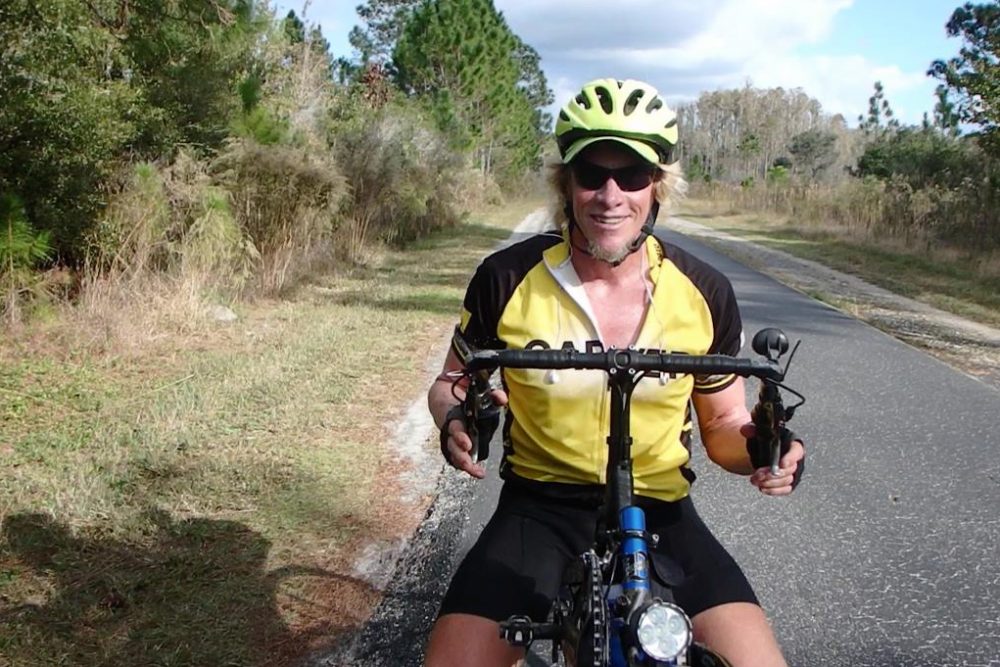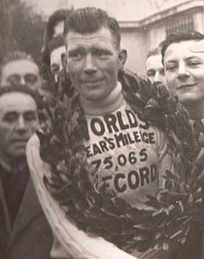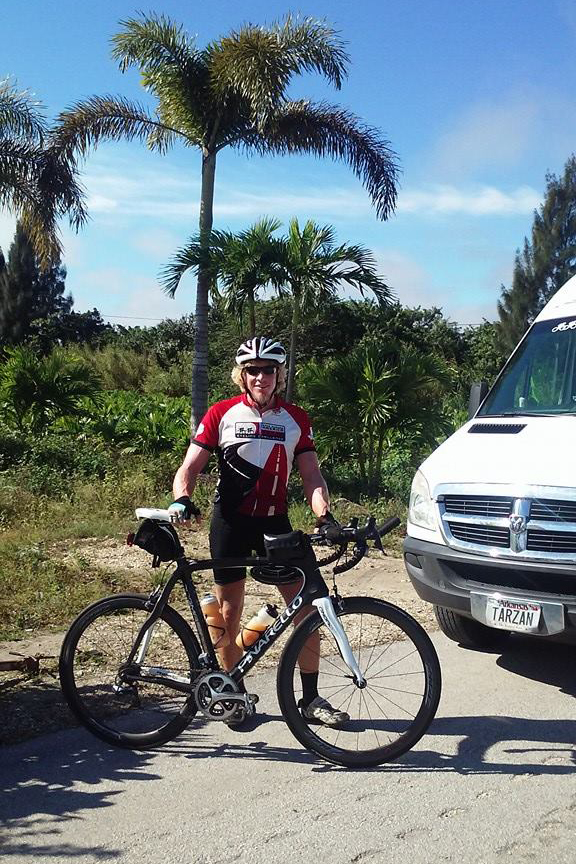Advertisement
Kurt Searvogel Cycles 75,065 Miles In A Year...And Keeps Going

When he and I spoke on Tuesday, Kurt Searvogel was finishing up his morning stretches. It was a little before 6:00 in the morning, which means he was running behind schedule.
"Normally I'll wake up around 5:00 and get some breakfast," Searvogel said, "and be on the bike around 6:00, pretty much ride until about 8:00 or 9:00 at night. Keep it to a 14-15 hour day and then — and then get enough sleep to keep going for the next day."
This has been Searvogel's schedule for 365 days in a row. Wake up. Ride 200 miles. Upload the data from his GPS. Eat and sleep.
On Monday, 53-year-old Kurt Searvogel passed mile 75,065, breaking the "Highest Annual Mileage Record" — or HAM'R. A 26-year-old Brit named Tommy Godwin set that mark in 1939, and for more than 75 years Godwin's record was considered unbreakable.
Kurt Searvogel did the undoable with five days to spare, which means he had most of this week to pad his record.
At the end of the day, the hardest thing of this record is getting on the bike and turning the pedals.
Dave Barter
"A lot of my fans are like, 'Ride, ride, ride! Make it really hard, make it impossible to break.'' said Searvogel. "It's like, 'OK, whatever. When the weather's nice, I'll ride. When not, I'll do something else. Like a sane person.'"
There's nothing sane about cycling the distance equal to three times around the earth in a single year. And no one knows that better than Dave Barter.
Barter has spent the last decade researching the history of the HAM'R — a mark that until 2015 went by the less boastful name "The Year Record." For his book, "The Year," Barter even attempted 200 miles in a single day.
"Well, I’ve done it a couple of times, and it has destroyed me both times," Barter said. "It’s a very long day. You’re looking at 12 to 14 hours in the saddle continuously turning the pedals out there in the elements."
But after those 200 mile days, Barter never said to himself, "Boy, I want to do that again for 364 more days."
"I absolutely did not," Barter confirmed.
Advertisement
HAM'R History
Barter is fascinated with cyclists, first in the U.S. and then in Britain, who began tackling enormous distances as far back as the 1890s. He calls them the "mile eaters."
"So this is how Tommy Godwin, for example, would have been described in his day?" I asked.
"Oh, yes," Barter said. "In his day he was effectively the king of the mile eaters. They weren’t riding for scenery, and they weren’t riding to win races. They were riding to eat miles, and this is how they became known as the mile eaters."
Sometimes mile eaters travel from place to place. And sometimes they stick to familiar roads. When we spoke on Tuesday, Kurt Searvogel was riding laps inside a Florida national park.
But let's get back to Tommy Godwin. He won a lot of races in the 1930s. But by 1939, faster riders had entered the sport, and Godwin was looking for a better way to make a living.
"Tommy wasn’t a rich man at all. He didn’t have a good job. And taking the year record would possibly lead him to sponsorship and a job in the cycling industry."
Godwin planned to ride in 50 mile shifts — four a day — to give his body the maximum recovery time. Almost immediately, Barter said, that plan fell apart.
"The winter in the UK in 1939 was absolutely atrocious. There were unprecedented levels of snow, wind and ice. And I’ve heard stories told that friends and colleagues had to clear roads so he could ride up and down the road continuously just to get miles in."
A dozen times a day, Godwin had to stop and find a witness to sign a signature card to verify his distance.
On top of all that, Godwin was a vegetarian. He fueled his 200 miles a day with nothing more than dairy products, fruit, eggs, bread and sweet treats — when he could get them.
"But you have to remember this is 1939 in Britain, when the war was beginning and so rationing was making certain food types scarce."
Did I forget to mention World War II?

"War was declared in September, 1939," Barter said. "When he heard, he stopped, picked up his bike, and threw it into a hedge in frustration. He was so close. He didn’t take the record until October the 26th, and he thought he’d be called up."
Tommy Godwin wasn't called up, at least not yet. But as the end of the year approached and the days got shorter and shorter, Godwin had to tape over his bike lights to comply with the blackout.
You'd think that after Tommy Godwin finished 1939 with his seemingly unbreakable 75,065 miles, he would have happily stepped off his bike. But not so.
"No. These high mileage rides were great for the sponsors at the time," Barter said. "So they gave him a contract to try and beat the 100,000 mile record which had been set by Rene Menzies at 587 days. So he carried on. Sadly, so did the weather, and the winter in 1940 was just as bad as it was in 1939."
Godwin completed the 100,000 mile challenge in exactly 500 days, finishing on May 14, 1940. Later that month, he was drafted into the Royal Air Force. By the time he returned, his record was all but forgotten.
75,065 And Counting
And that brings us back to this week and Kurt Searvogel, who hasn't been paid for his year on the bike. Searvogel has no intention of continuing on after this weekend…unless someone pays him $400,000.

"Back in the day when Tommy Godwin set this record, it was followed more widely by more people," said Outside Magazine's Tom Vanderbilt. "It was more picked up by more parts of the media and Godwin had big sponsors."
Vanderbilt profiled Searvogel for Outside Magazine. He's a cyclist who covers the sport, but he only discovered Searvogel's attempt by accident.
"Over the year more people began to find out," Vanderbilt said, "but this was a very low-budget, kind-of-DIY effort, and he had basically no sponsors, no media person. It was just him and his now-wife out there on the road making it up as they went along."
The Searvogels, who got married 10 months into this 12 month challenge, crisscrossed the country, chasing the good weather. When the cycling magazine that had certified Godwin's record back in 1939 announced that Searvogel had broken it, one angry Facebook fan responded by saying:
"Wow. Must be awsome [sic] to be able to ride your bike for 12 hours a day everyday on lovely, sunny, flat roads on a lovely new hi tech bike. This 'record' doesn't come close to the 1939 feat."
To be fair, Searvogel rode 14 to 15 hours a day. And Godwin didn't exactly search out hills either. Besides…
"Why would you ride into the wind for a full day if you didn’t have to? It just doesn’t make sense," said Vanderbilt.
Dave Barter said this isn't a story of apples and oranges.
"No, no, no. It’s not. Tommy got on his bike and turned the pedals every day. And Kurt got on his bike and turned the pedals every day. At the end of the day the hardest thing of this record is getting on the bike and turning the pedals. I think the attempts absolutely are comparable."
So Searvogel's record is comparable, and Vanderbilt said, "For the moment it appears basically untouchable."
Another challenger
Or is it? Because there's one cyclist who's been at this even longer than Kurt Searvogel. British cyclist Steve Abraham has been considering a challenge for years. There was just one problem.
"What Steve needed was an authority to validate his record," Dave Barter said, "and this is really important because otherwise he could have ridden for a whole year and everyone could have said, 'Well you didn’t do it.'"
In 2014, the UltraMarathon Cycling Association agreed to certify future record attempts. GPS and heart rate monitors became part of the documentation — to discourage cheating.

Abraham set out on Jan. 1, 2015. So why is this the story of Kurt Searvogel and not the story of Steve Abraham?
"Steve was knocked off his bike by a guy riding a moped, and he smashed his ankle. He broke it," Barter said.
Abraham had surgery to put his ankle back together. Ten days later, he was back on the bike — with one major change.
"The only way Steve could carry on eating miles, as we call it, was to use a recumbent and to pedal with one leg," Barter said. "And he was doing 100 miles a day pedaling with one leg while he rehabilitated the broken ankle."
Abraham re-started his attempt in August — that's allowed under the rules — and finished 2015 ahead of Searvogel's pace.
But Searvogel isn't worried about Abraham — or anyone else — breaking his record.
"Ahhh, not really. If they do, they do. If they don't, they don't," Searvogel said. "I don't worry about things I can't control."
When he and I spoke on Tuesday, Kurt Searvogel was pretty much focused on Sunday, when he could wake up for the first time in 365 days and not think about getting back on his bike. But that doesn't mean that he won't ride again.
"I don't know that I'll step away from the bike," Searvogel said. "I'll step away from riding big miles. Pretty much on the way home, Alicia and I plan on stopping at spots we've liked. Camp on the beach. Ride bikes up and down the beach for a while. Eat some good food. Go to the next spot. But not ride to the next spot. Drive to the next spot."
This segment aired on January 9, 2016.
